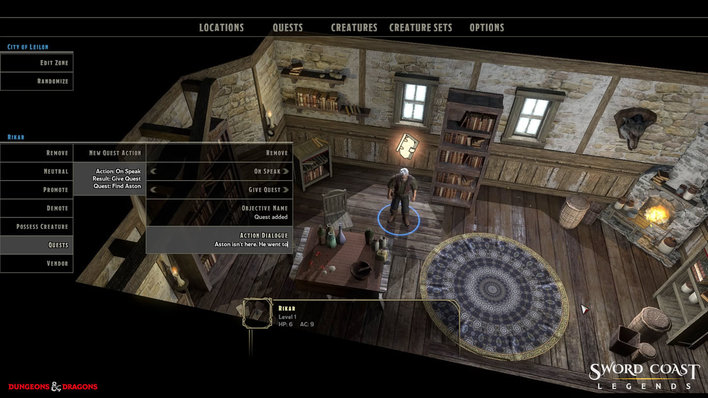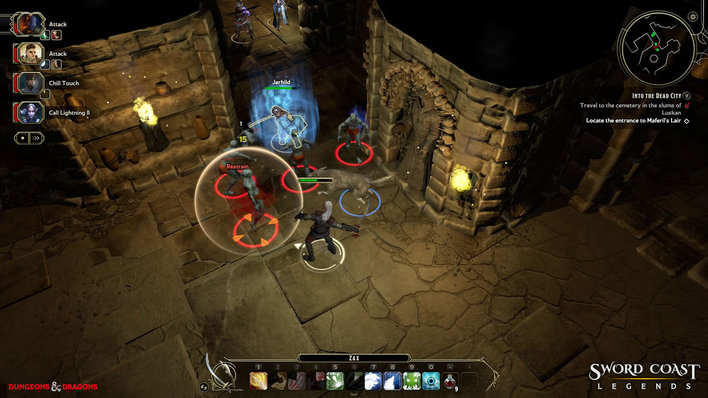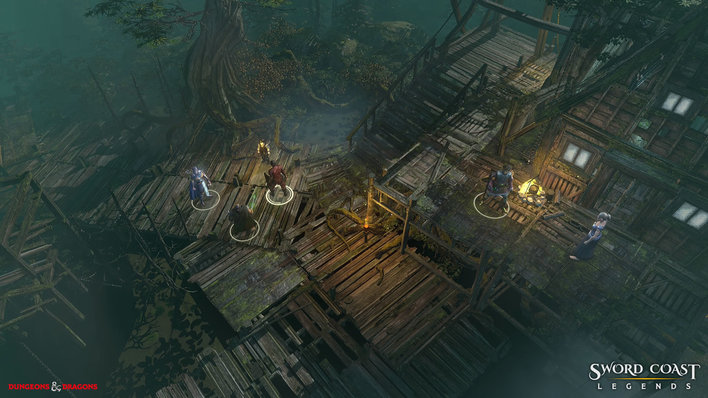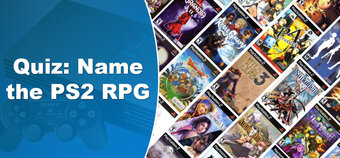In the weeks leading up to this year's gamescom, the world's largest games convention, one thing was clear - Sword Coast Legends was right near the top of our most wanted list. Set in the same world as classic PC role playing games like Baldur's Gate and Icewind Dale (along with a whole host of others), the game promises a return to the glory days of the Dungeons and Dragons games of old, which ticked all the right boxes in our jaded journo heart. After all, here was a game that would be like putting on a familiar old coat - we'd know exactly what to expect. There'd be a dwarf with a thing for kneecaps, a paladin who takes himself way too seriously, and a mage who keeps hilariously miscasting his spells and accidentally killing everyone else on his team. Perhaps we'd have to go and rescue someone's enchanted cloth so they could sleep well at night, or set out on a quest to find the legendary Almighty Blade of Butter Smiting + 5.
What we certainly didn't expect was to find ourselves under attack by a rogue shopkeeping lobster, before being cornered by a resurrected 60s/70s pop group, in preparation for our final climactic encounter with a gigantic irritated housewife, in a quest that could only have come from the deranged mind of a German games journalist, who put together the adventure on the fly, laughing maniacally to himself, as we tried our best to survive. Only at gamescom.
Such is the way with Sword Coast Legends, a game that seems intent on mixing the old with the new to create the Dungeons and Dragons game we'd always dreamed of having. While the game promises a fully featured, and suitably epic story mode for either a single player, or a group of friends to play through, it also comes with something that's even more exciting - a fully featured editor, that lets you create your own quests, characters, environments and encounters, through a simple, yet powerful interface. And the best bit? Even if you're playing on console, you'll still have access to the full featured editor, and can create your own levels/quests/adventures, or download ones other people have made too. That's some pretty impressive stuff.

The editor lets you bring out your inner Lawrence Llewelyn-Bowen
While it's been fairly common for PC games to come with a level editor (Neverwinter Nights was one of the famous ones, which shipped with the same developer tools the studio had used to make the game in the first place), it's sadly been a bit rarer on consoles, perhaps because of how complex the level editors always are - or perhaps because of how awkward they'd be to use without a mouse. Sword Coast Legends deftly sidesteps every issue involved, however, by building the editor into the game itself. With a simple, list based menu, you can edit, and place almost anything you could ever want to, from characters and enemies, to barrels and light sources. And as we found out for ourselves, it's pretty impressive when you see it in action.
The editor itself can essentially serve two purposes. First and foremost, you can use it to create your own levels from scratch in your own time, setting quests, writing lore, plonking down non player characters for your adventurer friends to chat to - whatever you want. You can then save those levels, give them a name, and upload them to a central server for other people to play through, whether they're your friends or otherwise. That on its own is exciting enough, offering infinite replayability, and the chance for a community to really sink their teeth into things - but there's more to this editor that meets the eye. You can also use it for Dungeon Master mode, which is, in essence, the game's multiplayer, as one person, with an all seeing eye and the ability to edit the level on the fly, takes a group of friends through the level, on an adventure...
When playing in Dungeon Master mode, things work a little bit differently. In the top right of the screen, you have a thing called DM Threat, which essentially controls how much the dungeon master can or can't do. Every action you perform uses up Threat points, to basically stop you spamming a room with all the strongest enemies in the game if you decide your friends are doing too well. Still, this adds a much needed balance to the game - if your friends are struggling, for example, you can downgrade the enemies their facing, or even outright delete them, which helps them out, and gets you some extra Threat points in the process.

Placing an enemy to surprise our "friends"
Whether you're playing live as a DM, or working on a masterpiece for your friends to play later, the toolset you have access to is essentially the same - and it's a very powerful thing. You can do essential scene dressing by setting the time of day and weather; you can give characters dialogue options, making the choices as complex or as ridiculous as you like; you can set when to assign quests, update quests, and complete quests, with all manner of triggers to choose from; and you can set traps and ambushes, so when your friends interact with a certain object, or enter a certain area, a foe of your choosing jumps out at them - perhaps even shouting a battle cry you'd written earlier.
As we kind of mentioned earlier, we got to see the full effect of the dungeon master when we went hands-on with the game at gamescom. Entering a cave with a party of plucky adventurers, a ranger, paladin, wizard, and a... something (we can't remember what the other character was), we set out on a quest with no idea what traps lay in store. Another journo on the day took the dungeon master's seat, and it was up to him to put the creation tools through their paces, and try to stop us reaching the end of the dungeon, and our quest destination - a battle against a gigantic ogre, armed with a giant rolling pin, which had been affectionately titled "Angry House Ogre". The dungeon master can customise every aspect of the characters they place in the level, setting their race, back story, abilities, weapons, and even the colour of their skin and costumes (hence our ogre being a very fetching shade of green).
Still, as the adventurers, you're blissfully unaware of what the dungeon master has up their sleeve. While you can tell if the dungeon master is around, as a small orb of light represents their cursor on your screen, if they're not in the same room, you have no idea what they're up to, whether they're locking doors, placing traps, creating a hidden room, or customising your next encounter.

Bring it on!
When it comes to encounters, the dungeon master has options. Located in the middle of each (substantial) room is a twenty sided dice, and by clicking that, the DM can choose from a variety of pre-set options for the encounters, choosing an easy, medium, or hard selection of monsters to ambush you - or telling the game to use an enemy set of their choosing. If they'd prefer, they could simply turn off the default encounter, and plonk their own set of enemies down as they see fit, choosing their location, level, and even, should they choose, taking over them directly, and telling them who to attack, making the game almost like a strategy game sometimes for the DM.
Still, as it turns out, despite our DM's best efforts, our ragtag bunch of adventurers worked surprisingly well as a fighting unit (even if we did end up seemingly really irritating our ranger, by accidentally walking off ahead before she'd had time to search for traps), and so rather than try to spend his time killing us, our DM tried a different tactic - to make us laugh ourselves to death instead. And so it was that we turned the corner to be greeted by a giant lobster, cunningly positioned to make use of a crevice as though it was some sort of giant hermit crab. And while the first thing to pop into our mind may have been "RUN!", it turns out this enemy had grown tired of fighting, and had instead set up his own shop to sell wares to passing adventurers. His name? Dr Zoidberg. ("Look at me! I'm Dr Zoidberg, shop owner!")
Unfortunately for us though, we'd been doing so well at that point that none of us actually needed to buy any supplies - something that apparently enraged the good doctor, as he metaphorically flipped over his stall, and instead came after us, in full on enemy mode. Cripes. No sooner had we turned and ran than we found ourselves in another room, where five zombies were stood in a row, just waiting for us. Their name? The Jackson 5.

Not everything in Sword Coast Legends takes place underground. Just our demo.
Stuck in between a rock and a hard place (or at the very least, a lobster and a former pop group), we were now in trouble. As the paladin in the group, it was up to us to stop the rest of the team from dying too quickly - something we struggled with to say the least, as one party member dropped after another. Before too long, it was just us, half of the Jackson 5, and Dr. Zoidberg left. But then, something miraculous happened. Seemingly realising he might have been a bit harsh before, Dr. Zoidberg suddenly became a friend, and started attacking the Jackson 5! Cutting through them like a giant lobster thing cuts through an ageing pop band, with our foes now slain (and our team mates resurrected), it was time for the final showdown, against the giant angry house ogre.
Realising his back was now up against the wall, the DM had to spend his Threat points wisely, choosing exactly the right time to spawn a few extra foes for us to vanquish. Unfortunately for him, our wizard character had been saving a spell (at the advice of one of the developers) until this very moment, and so no sooner had the boss fight begun than we rained down a steamy great fireball of apocalyptic proportions on the poor old house ogre, and just like that, the enemies were no more, the boss smouldered, and the DM dejected.
No matter how you choose to play, Sword Coast Legends has the potential to suck you in for hours on end. As a solo adventurer, you have an epic story to take on; if you're more of a creative type, you can create your own modules on PC or console, and share them with the world. If you like playing with your friends, you can come together with a group and take on the story - or, if you'd rather something a bit more unpredictable, one of you can become the dungeon master, and guide you on a quest of their own. More ambitious than any role playing game on the "next-gen" consoles so far, Sword Coast Legends is still near the top of our most wanted list. Hopefully now, it's on yours too! For more on the creation tools, check out the in depth (if a bit lengthy) video below.














